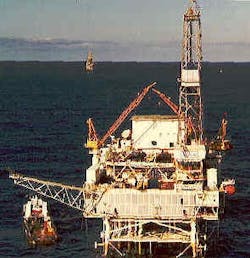Since 1977, Canary Labs, a provider of trending tools and services based in Martinsburg, Pa., has supplied trending software for the Chevron Hidalgo and Hermosa oil platforms, located off the coast of California. These platforms are now owned by Arguello Inc., which is based in Orcutt, Calif., and whose parent company is Plains Exploration & Production Co., based in Houston.
The Canary Labs trending solution was an add-on enhancement to the Intellution human-machine-interface (HMI) systems. The trending system monitors the salt water used for cooling, and provides trends on power, voltage, turbines and emissions, as well as data collection for Environmental Protection Agency (EPA) reporting to the State of California and the federal government.
In July of 2004, Canary Labs upgraded and installed the latest version of its Trend Link and Trend Historian software on the Hidalgo and Hermosa platforms, and implemented on-shore administration utilizing the OPC communication standards. The initial worry was the connection of different equipment and versions of software, but the OPC standard quickly resolved many of those concerns. During this upgrade, the Canary software was connected to the Intellution HMI via an OPC server that communicated to Modbus and Allen-Bradley brand programmable logic controllers (PLCs). Two Trend Historians and 10 to 15 Trend Link viewers were installed throughout the platforms and at the on-shore administration offices.
The Canary Labs data format implemented in 1997 was converted to the new historian format. There were over 4,000 files that consumed about 3.3 GigaBytes (GB) in file space. The newly formatted files were converted to one-week files and consumed about 350 MegaBytes, which freed approximately 3 GB of disk space. Arguello likes the ability to provide a minimum of two years of on-line data with fast response times to the operators, while minimizing the performance impact to the existing system. The ease of use of the trending products also requires less operator training while still providing the needed data.
During a follow-up visit in May of 2005, the Canary trending system was connected directly to the PLCs via a Kepware OPC server. By having the Canary Trend Historian separate from the Intellution HMI system, there is a degree of independence and redundancy. If an HMI system were to go down temporarily, the users still have access to the historical and current data values by looking at the trend charts. Also, any updates and future changes to the software would not affect the Canary Trending solution. Operators would be able to view the data without running blind, should one system need to go down for a short period of time.
Users normally look at the HMI screens and the alarm summary page. When an alarm sounds, they immediately see where the alarm is and bring up the Trend Link screen and load the appropriate chart (of the many they have) to see the variables that were alarming and how fast they are changing. If a problem keeps recurring, users will investigate it by examining historical data of previous occurrences and looking for patterns that would indicate the problem. Also, the historical data is used to satisfy the EPA requirements.
The platforms and offices are connected with an intranet system that allows data to be viewed anywhere on the network. Affordability and usability were the keys in selecting the Canary software. Also important was the ability to view annotations describing situations that have occurred and been resolved, with the relevant data on the chart available to all Trend Link viewers on the network.
The Canary support team provided technical engineering help over a three-year period in selecting servers, and for installation, setup, checkup and training during all phases of the project. During the project, the on-shore office was moved to a different location and Canary installed the software at the new office for the management team and system engineers. During this time, it was discovered that three tags were not being logged for a new well on the Hidalgo platform. The problem was quickly resolved by using the Canary remote administration tools, and the data was being collected to the Trend Historian within seconds, saving time and money by eliminating a flight to the platform.
K.C. Rockwell, senior facilities engineering manager, says, “The Canary trending software is a valuable tool and a real help for starting new wells and bringing them into production.”
For more information about historical trending solutions from Canary Labs, visit www.canarylabs.com.

